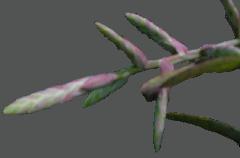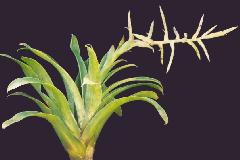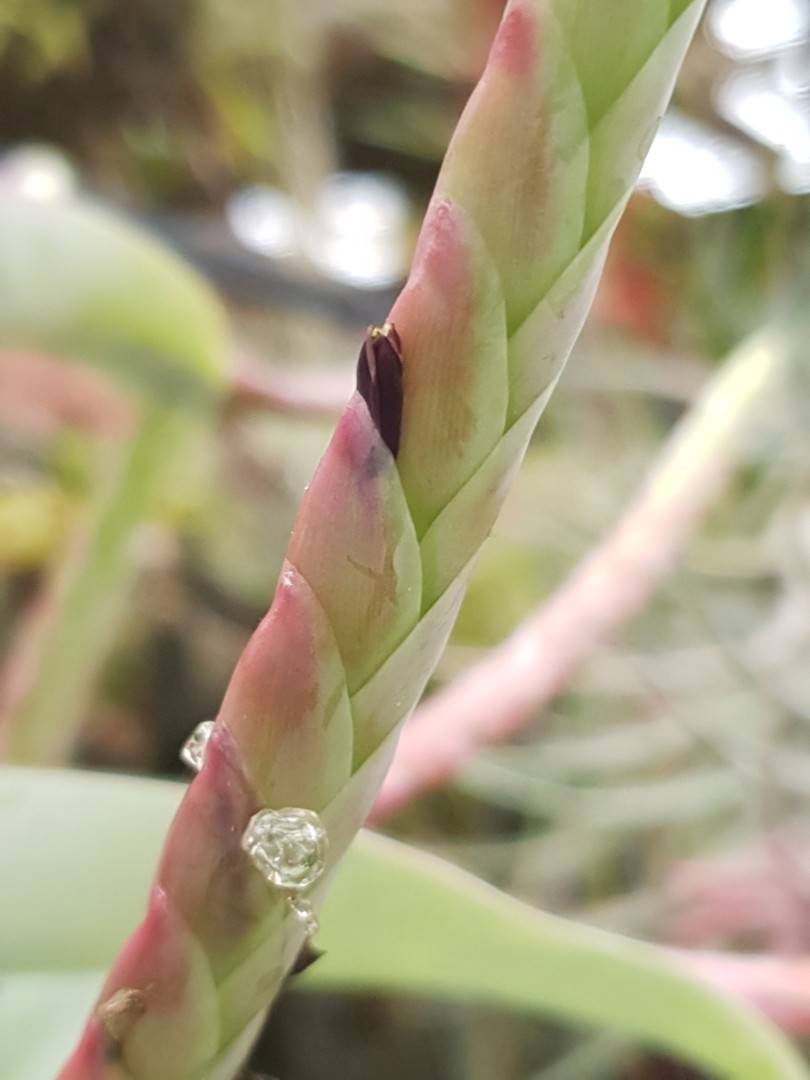



Etymology: Die Pflanze wurde LYMAN B. SMITH, Senior Botanist of the Smithsonian Institution, Washington, dem derzeit besten Bromelienkenner, dediziert.
Tillandsia lymanii bildet stammlose oder mit kurzen, dicken, aufrechten Stammen versehene, bis 80 cm hohe und bis 80 cm breite, aufrechte Trichterrosetten (Abb. 7, links und Abb. 8), die an ihrer Basis zahlreiche “Adventivkindel" erzeugen. Die B1attscheiden werden bis 20 cm lang und bis 10 cm breit; sic sind beiderseits angedruckt braun beschuppt und undeutlich von den zungenformigen, bis 50 cm langen und bis 7 cm breiten, in eine kurze, zuruckgerollte Spitze sich verschmalernden Spreiten abgesetzt. Im Jugendstadium sind diese dicht grau beschuppt (Abb. 7, rechts); mit zunehmenden Alter verkahlen sic mehr und mehr und nehmen infolge der Ausscheidung eines dicken Wachsbelages ein graugrunes, kreidiges Aussehen an. An sehr sonnigen Standorten weisen die Spreiten zudem noch eine dunkelweinrote Fleckung auf.
Der bis 2 cm dicke und bis 60 cm lange Infloreszenzschaft ist aufrecht oder gebogen und von subfoliaten Hochb1attern dicht umscheidet (Abb. 8, unten). In Form, Farbung und Beschuppung gleichen sie den Laubblattern, werden aber spitzenwarts kleiner und sind viel langer als die Internodien; ihre stengelumfassende Scheide geht allmahlich in eine kurze, zungenformige, an der Spitze zuruckgerollte, rotlich-grune, grauwachsig bereifte Spitze uber.
Die aus 10-20 Ahren locker zusammengesetzte, bi-, selten tripinnate Inf1oreszenz ist zumeist horizontal orientiert (Abb. 8, unten) und wird bei einem Dm bis zu 40 cm etwa 60 cm lang. Ihre kantig gefurchte Rhachis ist kahl, grun oder karminrot und wachsig bereift.
Die 2-4 cm langen Primarbrakteen sind zwar viel kurzer als die Ahren, aber langer als deren etwa 1,5 cm langer, steriler Basalabschnitt; sie sind den oberen Hochblattern ahnlich, wachsig bereift, unterseits kahl, oberseits jedoch zerstreut beschuppt. Die praefloral aufgerichteten, z. Z. der Anthese aber waagrecht von der Rhachis abstehenden, kurzgestielten Ahren sind schmal.-lineal, 1,5 bis 2 cm breit, 8-15 cm lang und meist mehr als 20-blutig (Abb. 8, unten; Abb. 9).
Die distich und dicht imbrikat angeordneten, z. Z. der Anthese aufgerichteten, postfloral jedoch spreizenden floralen Brakteen sind ecarinat, an der Basis 2-kielig excavat, 2-2,5 cm lang, (ausgebreitet) bis 1,3 cm breit und an der Spitze abgerundet, aber mit einer sehr kurzen Stachelspitze versehen; sie sind im frischen Zustand glatt, getrocknet jedoch genervt, karminrot, wachsig bereift, unterseits kahl, oberseits zerstreut angedruckt lepidot.
Die von den floralen Brakteen uberragten Sepalen sind nur bis 1,5 cm lang, 5 mm breit, an der Spitze abgerundet; die beiden adaxialen sind carinat, etwa 3 mm hoch verwachsen, grun, kahl und nur oberseits zerstreut beschuppt. Die dunkel-schwarz-violetten, zungenformigen, an der Spitze abgerundeten, aufrechten Peta1en uberragen die floralen Brakteen nur um wenige mm und schlieBen Staubblatter und Griffel. ein (Abb. 9, rechts).
Fundort: steile Felswande des Rio Chancay, zwischen 600 und 800 m, an der Strasse nach Santa Cruz, zwischen km 6 und 15 ostlich der Rio Chancay-Brucke (Dept. Cajamarca, Nordperu; Abb. 20.).
T. lymanii ist eine ausgesprochen epilithische, grosse Trichter-Tillandsie, die vegetativ mit ihren grau-wachsig bereiften, dunkelweinrot gefarbten Blattern der ca. 50 km (Luftlinie) weiter sudlich im Tal des Rio Sana in gleicher Vergesellschaftung und in gleicher Hohenlage wach¬senden T. rauhii L. B. SMITH gleicht. Vegetativ kann T. lymanii aber aueh mit T. teres L. B. SMITH (s. Abb. 18; Abb. 19 bei RAUH, Bromelienstudien I, 1973) verwechselt werden. Obwohl die letztere in dem nur wenige Kilometer nordlich gelegenen Nachbartal Llama-Huam bos an gleichen Standorten und in gleicher Hohenlage Massenbestande bildet, wurde sie im Tal des Rio Chancay nicht festgestellt. Umgekehrt ist T. lymanii in jenem Tal nicht zu finden; beide Taler sind durch eine uber 3000 m hohe Bergkette voneinander getrennt, wodurch wohl ein Austausch verhindert wird.
Mit den vorstehend genannten Arten, T. rauhii und T. teres, hat T. lymanii gemeinsam, dass alle drei sehr grosse Trichterrosetten bilden, die steile Felswande besiedeln und ihre dicht beschuppten Jugendstadien erheblich von den kahlen, wachsig-bereiften Altersstadien abweichen. Gemeinsam ist ihnen ferner die Erscheinung der sog. "Adventiv- kindelbildung" (s. RAUH, "Bromelien", Bd. I, 1970, S. 100), d.h. dass an der Basis der Rosettenachse zahlreiche "Kindeln" auftreten, bevor die Pflanzen ihre Bluhfahigkeit erlangen.
Zur -Blutezeit aber unterscheiden sich alle drei Arten hinsichtlich ihrer Infloreszenz- und Blutenmorphologie so stark voneinander, dass direkte verwandtschaftliche Beziehungen zwischen ihnen nicht angenommen werden konnen. T. lymanii ist eine eigene Art, deren Ahren viel schmaler als bei T. rauhii, jedoch breiter und abgeflachter als bei T. teres sind.
Nach dem Bestimmungsschlussel von L. B. SMITH (Subkey IX, 1970), ware T. lymanii in die Nahe der von Mexico bis Honduras verbreiteten T. lucida E. MORR. ex Bak., resp. der von Venezuela bis Peru verbreiteten T. denudata Andre zu stellen, doch auch zu diesen weist T. lymanii keine verwandtschaftlichen Beziehungen auf.
Translated by Butcher
Plant stemless or with short, thick, erect stem, to 80 cm high and to 80 cm wide,with an erect funnel rosette (fig. 7, left and fig. 8), that has numerous adventitious offsets at the base.
Leaf sheath to 20 cm long and to 10 cm wide; brown appressed scales on both sides and indistinct from the tongue shaped, to 50 cm long and to 7 cm wide, blade narrowing to a short, rolled over tip. When young, these are densely grey scaled (fig. 7, right); with increasing age more and more glabrous and looks grey green because of the removal of the thick frosty wax coating. In very sunny locations, the blades show a dark-wine-red flecking.
Peduncle to 2 cm thick and to 60 cm long, erect or bent over and densely covered by subfoliate peduncle bracts,(fig. 8, below). In form, colour and amount of scales, they resemble the foliage leaves, however becoming smaller towards the top and are much longer than the internodes; its stem extensively covered by sheaths that gradually become short, tongue-like, rolled over at the top, reddish green, grey wax frosted top.
Inflorescence with from 10-20 lax compound spikes, bi-, rarely tripinnate are oriented mostly horizontally,( fig. 8, below), becoming about 10cm up to 40cm, sometimes 60 cm long. Its angular furrowed Rhachis is glabrous, green or crimson and wax frosted.
Primary bracts 2-4 cm long are admittedly much shorter than the spikes, but about 1.5cm longer than the sterile basal section; similar to the upper peduncle bracts, wax frosted, underneath glabrous, upper side with scattered scales.
Spikes short stemmed, prefloral are erect, but at anthesis these are horizontal to the rhachis, are narrow linear, 1,5 to 2 cm wide, 8-15 cm long and usually more than 20-flowered,( fig. 8, below; fig. 9).
Floral bracts distichous and densely imbricate, at anthesis are erect, postfloral, however, spreading are ecarinate, at the base 2 keeled excavated, 2-2,5 cm long, extended, to 1,3 cm wide and rounded at the tip, but with a very short sined tip; smooth in the fresh condition, but nerved when dry, crimson, wax frosted, underneath glabrous, upper side scattered appressed lepidote.
Sepals exceeded by the floral bracts are only to 1,5 cm long, 5 mm wide, rounded at the tip; the adaxial pair are carinate, about 3 mm high connate, green, glabrous and only the upper side scattered scaled.
Petals dark-black-violet, tongue shaped, rounded at the tip, erect. exceeding the floral bracts by only a few mm and enclosing the stamens and style (fig. 9, right).
Place of discovery: steep rocky area of the Rio Chancay, between 600 and 800 m, on the road from Santa Cruz, between km 6 and 15 east of Rio Chancay-Brucke (Dept. Cajamarca, North Peru; fig. 20.).
T. lymanii is an extreme epilithic, large funnel shaped Tillandsia, that vegetatively has grey wax frosted, dark wine red leaves that grows about 50 km (as the crow flies) south of Tal des Rio Sana in similar company and at a similar height with the similar T. rauhii L. B. Smith. T. lymanii can however be confused vegetatively with T. teres L. B. Smith (See Fig. 18; fig. 19 in Rauh, Bromelienstudien I 1973). Although the latter is found in masses a few kilometers north next to the nearby Llama Huambos at similar locations and at the same height, it was not found in the valley of the Rio Chancay. T. lymanii is not found in that valley, both valleys, by being separated by an over 3000 m high mountain-chain from each other, prevent exchange.
With the prominent named species, T. rauhii and T. teres, T. lymanii has in common with all three by having very large funnel shaped rosettes, growing on steep rocky areas and their leaves densely scaled in juvenile forms that with age change to glabrous, wax frosted. The appearance of the so-called adventitious offsets is common (see Rauh, "Bromelien", volume, I, 1970, p. 100), i.e. these appear at the base of the leaf rosette as numerous offsets before the plants attain their flowering period.
As to their flowering, all three species differ regarding their inflorescence and floral morphology so strongly from each other that there is no direct relationship between them. T. lymanii is an individual species, whose spikes are much narrower than T. rauhii, but wider and flatter than T. teres.
The Key of L. B. Smith,( Subkey IX, 1970), leads T. lymanii near to T. lucida E. Morr. ex Bak., dispersed from Mexico to Honduras and T. denudata Andre that is widespread from Venezuela to Peru, however T. lymanii has no relational relationship with them.
Detail from J Brom Soc 30(6): 247. 1980
Plant forms stemless rosettes, up to 80 cm high and 80 cm wide, which produce at their rhizomate bases (before flowering) numerous adventious offshoots.
Leaves in the young stages the blades are densely lepidote, in the adult stages the lingulate leaves (50 cm long and 7 cm wide) are glabrous and covered with a thick layer of wax and look therefore greenish-whitish, in full sunshine the color turns a dark wine red.
Scape is erect, 40 – 60cm long, very thick (2cm or more), covered with subfoliate bracts;
Inflorescence horizontally or pendant is bi(rarely) tripinnate, about 60 cm long and 40 cm wide; the rachis is glabrous, green or carmine red and waxy;
Spikes short stipitate, 10 – 20, are horizontally spreading, narrow-lineal, 8-15 cm long, 1,5-2 cm wide and mostly more than 20-flowered.
Floral bracts distichous, erect at anthesis and postfloral spreading, ecarinate, up to 2,5 cm long, densely imbricate, carmine red, waxy and sparsely lepidote, exceeding the sepals;
Sepals only 1,5 cm long, the posterior ones carinate and connate for 3mm;
Petals dark-brown violet, are only a little longer than the floral bracts;
Stamens and style included.
Type locality In the river valley Rio Chancay, on steep cliffs, between 600 and 800m, between 6km and 15km on the road towards Santa Cruz (Dept. Cajamarca) Peru
HOLOTYPE Rauh 35345 (Oct 1973) in herb. inst. bot. system. heidelbergensis (HEID)
The relationship of T. lymanii to any other Peruvian Tillandsia is not cleared up. In any case, it is not related to Tillandsia rauhii, which grows in the same region, although the vegetative rosettes of both species are very similar.
NOTES
1) see: "Bromelienstudien" IV, in "Tropische und Subtropische Pflanzenwelt" 13 (1974)
2) In T. rauhii we have the appearance: the leaves of young plants are densely lepidote, the leaves of old plants are glabrous and grayish waxy.
1997 Hiroyuki Takizawa & Dennis Cathcart report viviparous forms in 1997